
The Rise of Google Cloud: A Revenue Surge Driven by Partnership with OpenAI
In the ever-evolving world of technology, Google Cloud has recently emerged as a powerful contender in the AI landscape. In Q2 of 2025, the tech giant reported a remarkable 32% growth in cloud revenue, totaling $13.6 billion, significantly up from $10.3 billion during the same quarter last year. This surge is strongly attributed to its partnership with OpenAI, a collaboration that is shaping the future dynamics of AI development and infrastructure.
The Strategic Alliance: Collaboration Amid Competition
The partnership between Google Cloud and OpenAI represents a strategic shift that reflects both collaboration and rivalry within the tech industry. During Google’s recent earnings call, CEO Sundar Pichai framed this alliance as vital for enhancing the company's capabilities while also fulfilling OpenAI's demanding computational needs. This isn’t merely a one-sided relationship; by leveraging Google’s advanced computing hardware, including Nvidia GPUs and Tensor Processing Units (TPUs), OpenAI is set to enhance its renowned generative models, such as ChatGPT.
The Broader Implications for the AI Ecosystem
This strategic partnership underscores a significant trend in the tech sector where resource-sharing is becoming commonplace among competitors. With AI models requiring increasingly sophisticated infrastructure, the alliance helps mitigate supply chain risks while accelerating research and development timelines. For Google, tapping into OpenAI’s market deepens its footprint in the lucrative AI infrastructure market, forecasted to grow in tandem with AI's explosive demand.
Challenges and Opportunities: A Delicate Balance
Despite the growth opportunities presented by the partnership, there are inherent tensions. OpenAI’s momentum in the AI domain poses a threat to Google’s core search offerings, presenting a paradox where Google supports a rival that could potentially disrupt its profitable business model. To manage this delicate balance, Google plans to invest approximately $10 billion in 2025 to develop its own AI capabilities, including an initiative called Gemini.
Lessons from the Past: Competitive Collaborations
Looking back at the tech industry’s history, collaboration has often evolved into competition. A classic example is Google’s initial relationship with Yahoo, which began cooperatively but ultimately turned competitive. This historical context serves as a reminder of the shifting landscapes within technology and can provide insights into how the current dynamics might unfold.
Future Outlook: The Next Generation of AI Development
With OpenAI’s access to Google Cloud infrastructure, the development of next-generation AI models could be accelerated significantly. Analysts predict that this collaboration will heighten competition not only between Google and OpenAI but also against other key players like Microsoft. As the battle for dominance in the AI landscape intensifies, Google’s strategy to harness both partnerships and its in-house development capabilities could prove to be a winning formula.
Conclusion: Implications for Tech and Beyond
In conclusion, Google Cloud's partnership with OpenAI not only exemplifies the rapid evolution of AI technologies but also reveals the complexities of collaboration and competition in the tech industry. As companies adapt to the insatiable demand for AI tools and capabilities, the decisions made today will shape the technological landscape of tomorrow. Businesses must take note of such alliances to harness opportunities and prepare for potential disruptions in their sectors.
 Add Row
Add Row  Add
Add 




Write A Comment